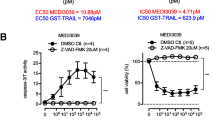Abstract
Purpose
Tumor necrosis factor-related apoptosis-inducing ligand (TRAIL) is a member of the TNF superfamily and has been shown to induce extrinsic pathway of apoptosis in many types of cancer cells. AT-101, an (−)-enantiomer of gossypol, is a potent anticancer agent that is shown to be an inhibitor of Bcl-2/Bcl-XL. In this study, we searched whether pretreatment with either of these drugs would result in the enhancement of apoptosis through induction of death receptors and activation of mitochondrial pathways within breast cancer cells.
Methods
Human breast cancer (MCF-7 and MDA-MB-231) and normal breast cells (MCF-10A) were treated with drugs alone/in combination/sequentially. XTT cell viability assay was used to evaluate cytotoxicity. For showing apoptosis, both DNA Fragmentation and caspase 3/7 activity measurements were done. ELISA and Western blot analysis were done to assess DR4 and DR5 protein levels. The expression levels of apoptotic proteins were assessed by human apoptosis antibody array.
Results
The sequential treatment of AT-101 followed by TRAIL resulted in significant synergistic cytotoxicity and apoptosis. Moreover, pretreatment of breast cancer cells with AT-101 and then with TRAIL caused enhancement of the expression levels of DR4 and DR5 in both cancer cell lines, suggesting that these cells were under strong apoptotic stimuli.
Conclusions
These findings all together, strongly suggest that pretreatment with AT-101 enhances TRAIL-induced death-inducing signaling complex resulting in the engagement of the mitochondrial pathway to apoptosis in breast cancer cells. These promising, preliminary results make AT-101 and TRAIL a novel combination treatment candidate for breast cancer.







Similar content being viewed by others
References
Baggstrom MQ, Qi Y, Koczywas M, Argiris A, Johnson EA, Millward MJ, Murphy SC, Erlichman C, Rudin CM, Govindan R (2011) A phase II study of AT-101 (Gossypol) in chemotherapy-sensitive recurrent extensive-stage small cell lung cancer. J Thorac Oncol 6:1757–1760. doi:10.1097/JTO.0b013e31822e2941
Chou TC, Talalay P (1984) Quantitative analysis of dose-effect relationships: the combined effects of multiple drugs or enzyme inhibitors. Adv Enzyme Regul 22:27–55. doi:10.1016/0065-2571542(84)90007-4
Erten C, Karaca B, Kucukzeybek Y, Gorumlu G, Cengiz E, Gul MK, Atmaca H, Uzunoglu S, Karabulut B, Sanli UA, Uslu R (2009) Regulation of growth factors in hormone- and drug resistant prostate cancer cells by synergistic combination of docetaxel and octreotide. BJU Int 104:107–114. doi:10.1111/j.1464-410X.2009.08340.x
Gonzalvez F, Ashkenazi A (2010) New insights into apoptosis signaling by Apo2L/TRAIL. Oncogene 29:4752–4765. doi:10.1038/onc.2010.221
Johnstone RW, Frew AJ, Smyth MJ (2008) The TRAIL apoptotic pathway in cancer onset, progression and therapy. Nat Rev Cancer 8:782–798
Keane MM, Ettenberg SA, Nau MM, Russell EK, Lipkowitz S (1999) Chemotherapy augments TRAIL-induced apoptosis in breast cell lines. Cancer Res 59:734–741
Kim KH, Seo HS, Choi HS, Choi I, Shin YC, Ko SG (2011) Induction of apoptotic cell death by ursolic acid through mitochondrial death pathway and extrinsic death receptor pathway in MDA-MB-231 cells. Arch Pharm Res 34:1363–1372. doi:10.1007/s12272-011-0817-5
Kline MP, Rajkumar SV, Timm MM, Kimlinger TK, Haug JL, Lust JA, Greipp PR, Kumar S (2008) R-(-)gossypol (AT-101) activates programmed cell death in multiple myeloma cells. Exp Hematol 36:568–576. doi:10.1016/j.exphem.2008.01.003
Moretti L, Li B, Kim KW, Chen H, Lu B (2010) AT-101, a Pan-Bcl-2 inhibitor, leads to radiosensitization of non-small cell lung cancer. J Thorac Oncol 5:680–687. doi:10.1097/JTO.0b013e3181d6e08e
Nimmanapalli R, Perkins CL, Orlando M, O’Bryan E, Nguyen D, Bhalla KN (2001) Pretreatment with paclitaxel enhances apo-2 ligand/tumor necrosis factor-related apoptosisinducing ligand-induced apoptosis of prostate cancer cells by inducing death receptors 4 and 5 protein levels. Cancer Res 61:759–763
Oktem G, Karabulut B, Selvi N, Sezgin C, Sanli UA, Uslu R, Yurtseven ME, Omay SB (2004) Differential effects of doxorubicin and docetaxel on nitric oxide production and inducible nitric oxide synthase expression in MCF-7 human breast cancer cells. Oncol Res 14:381–386
Pennarun B, Meijer A, de Vries EG, Kleibeuk er JH, Kruyt F, de Jong S (2010) Playing the DISC: turning on TRAIL death receptor-mediated apoptosis in cancer. Biochim Biophys Acta 1805:123–140. doi:10.1016/j.bbcan.2009.11.004
Singh TR, Shankar S, Chen X, Asim M, Srivastava RK (2003) Synergistic interactions of chemotherapeutic drugs and tumor necrosis factor-related apoptosis-inducing ligand/Apo-2 ligand on apoptosis and on regression of breast carcinoma in vivo. Cancer Res 63:5390–5400
Wagner KW, Punnoose EA, Janua rio T, Lawrence DA, Pitti RM, Lancaster K, Lee D, von Goetz M, Yee SF, Totpal K, Huw L, Katta V, Cavet G, Hymowitz SG, Amler L, Ashkenazi A (2007) Death-receptor O-glycosylation controls tumor-cell sensitivity to the proapoptotic ligand Apo2L/TRAIL. Nat Med 13:1070–1077
Wang S (2008) The promise of cancer therapeutics targeting the TNF-related apoptosis inducing ligand and TRAIL receptor pathway. Oncogene 27:6207–6215
Wilson NS, Dixit V, Ashkenazi A (2009) Death receptor signal transducers: nodes of coordination in immune signaling networks. Nat Immunol 10:348–355
Yang A, Wilson NS, Ashkenazi A (2010) Proapoptotic DR4 and DR5 signaling in cancer cells: toward clinical translation. Curr Opin Cell Biol 22:837–844. doi:10.1016/j.ceb.2010.08.001
Yeow WS, Baras A, Chua A, Nguyen DM, Sehgal SS, Schrump DS, Nguyen DM (2006) Gossypol, a phytochemical with BH3-mimetic property, sensitizes cultured thoracic cancer cells to Apo2 ligand/tumor necrosis factor-related apoptosis-inducing ligand. J Thorac Cardiovasc Surg 132:1356–1362. doi:10.1016/j.jtcvs.2006.07.025
Acknowledgments
This work was supported by grants from Celal Bayar University Scientific Research Projects Committee of Celal Bayar University. (Project No: FBE 2009-093).
Conflict of interest
The authors declare that they have no conflict of interest.
Author information
Authors and Affiliations
Corresponding author
Rights and permissions
About this article
Cite this article
Kisim, A., Atmaca, H., Cakar, B. et al. Pretreatment with AT-101 enhances tumor necrosis factor-related apoptosis-inducing ligand (TRAIL)-induced apoptosis of breast cancer cells by inducing death receptors 4 and 5 protein levels. J Cancer Res Clin Oncol 138, 1155–1163 (2012). https://doi.org/10.1007/s00432-012-1187-1
Received:
Accepted:
Published:
Issue Date:
DOI: https://doi.org/10.1007/s00432-012-1187-1




